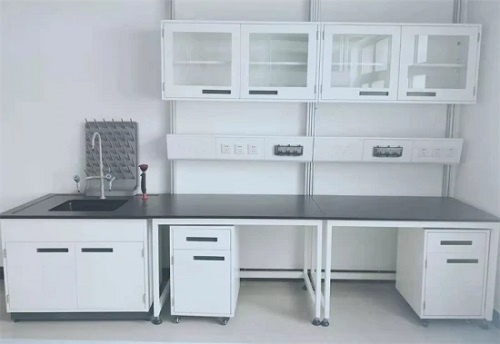Laboratories demand precision, organization, and safety, making a well-crafted lab bench with drawers indispensable. This essential component improves workflow productivity, reduces clutter, and promotes a safer work environment by offering easily accessible storage. However, the design process needs painstaking attention to assure usefulness, longevity, and industry compliance. This detailed tutorial will go over key issues and best practices for building a lab table with drawers. From defining its function and assuring ergonomic accessibility to choosing lasting materials, arranging drawers effectively, and stressing safety compliance, we'll go over the subtleties of designing a workplace that not only meets but surpasses the needs of a modern laboratory.
Why Planning is Essential?
Effective planning is essential when selecting lab tables with drawers for your laboratory. By carefully assessing your requirements, you may guarantee that the table satisfies the safety regulations for handling dangerous products and has chemical-resistant surfaces. Custom choices enable smooth integration of scientific equipment and effective organization. Effective lab layout maximizes storage, reduces clutter, and fosters a safe and productive atmosphere. Tailored lab tables with drawers fit specific needs, encouraging efficient workflows and accessibility. By taking the time to prepare, you may choose a lab table that meets your laboratory's unique needs while also improving overall functionality.
Considerations in Planning a Table with Drawers:
Purpose and functionality
The initial phase in crafting a lab table with drawers involves discerning its intended purpose and functionality, tailored to the unique requirements of your laboratory environment. Whether it's a chemical lab, a biology lab, or a multidisciplinary research center, understanding the broad range of equipment, instruments, and supplies that must be stored in the drawers is critical. This understanding not only helps to determine the proper table size, design, and arrangement, but it also guarantees that it successfully supports the laboratory's unique demands and operations.
Ergonomics and Accessibility
Ergonomics is an important consideration when designing lab tables that maximize user comfort and productivity. Ensure that the table height is appropriate for the responsibilities being performed so that researchers can work efficiently and without discomfort or fatigue. Consider drawer location and accessibility. Drawers should be easily accessible without needing extensive bending or stretching, lowering the risk of injury while increasing efficiency.
Material Selection
Durable and functional lab desks are mainly based on material choices, especially in terms of chemical resistance, easy cleaning, and weight capacity Stainless steel stands out as the first choice due to its strength uniqueness, and corrosion resistance, making it ideal for areas where chemicals are constantly used. Due to low maintenance requirements and resistance to stains and stains, these materials ensure the longevity and performance of the lab table, providing reliability and efficiency in demanding lab environments with clean, strong durability and chemical resistance are of paramount importance.
Drawer Design and Organization
The drawer design and arrangement have a considerable influence on the lab table's efficiency. Consider the goods that will be stored and emphasize accessibility and organization. Use a mix of shallow and deep drawers to accommodate various-sized objects while keeping regularly used equipment and supplies easily accessible. Dividers, trays, and adjustable inserts can help keep contents organized and reduce clutter.
Safety and Compliance
When designing laboratory furniture, safety should always come first. Ensure that the lab table's materials and structure meet all necessary safety requirements and laws. To reduce the chance of accidents and contamination, look for elements like rounded edges, strong construction, and chemically resistant surfaces. Consider integrating features like drawer-locking mechanisms to keep dangerous chemicals secure while not in use.
Flexible and adaptable
A well-designed lab table should be versatile and adaptive to changing requirements and procedures. Consider modular or adjustable designs that allow for simple reconfiguration as needs change. Adjustable-height desks, for example, can accommodate researchers of various heights and preferences, and detachable or interchangeable drawer inserts provide for greater storage versatility.
Integration with the Laboratory Infrastructure
Integration with the current lab infrastructure is another critical factor when designing a lab table with drawers. Check that the table's size, utilities, and connectivity choices are consistent with the laboratory space arrangement. Consider access to power outlets, gas lines, and other utilities, as well as compatibility with nearby equipment and workstations. Proper integration will enable a smooth workflow and optimize the utilization of laboratory resources.
Maintenance and Durability
The lifetime and optimal performance of laboratory tables need a commitment to regular maintenance measures. Choose materials and finishes that are both easy to maintain and resistant to wear. Establishing a complete maintenance program is critical, which includes frequent inspections, thorough cleaning, and timely repairs for both the table and its drawers. Encouraging laboratory workers to use appropriate procedures while handling and storing materials is equally important. This decreases the possibility of damage and extends the total life of the furniture. A proactive maintenance approach not only preserves your lab furniture investment but also helps to make the workplace safer and more efficient.
You Must Read: Selecting Lab Chairs with Armrests: A Comprehensive Guide for Comfort and Safety
Conclusion
To summarize, constructing an effective laboratory table with drawers requires careful planning and attention to detail. By taking into account variables like as purpose, ergonomics, material selection, safety compliance, and maintenance, you can design a workplace that fulfills the specific requirements of your laboratory. Investing in high-quality materials and smart design elements may help you increase workflow efficiency, minimize clutter, and create a safer work environment. Furthermore, executing a complete maintenance schedule ensures that the lab table lasts as long as possible and functions well, protecting your investment and contributing to a fruitful study atmosphere. By following these essential principles and best practices, you can design a lab table that improves productivity, organization, and safety in your lab.







 (2).png)
.png)


 (1).png)
.png)